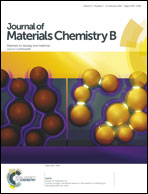Preparation of protein imprinted polymer beads by Pickering emulsion polymerization†
Abstract
We present a new method for preparation of protein-specific polymer beads based on surface molecular imprinting in Pickering emulsion. In the first step, adult human hemoglobin (Hb) was adsorbed on silica nanoparticles. The protein-coated silica particles were then used to stabilize an oil-in-water emulsion (Pickering emulsion) composed of cross-linking monomer in the oil phase. After free radical polymerization of the oil phase, the protein-silica particles were removed to leave Hb-imprinted sites on the polymer surface. The protein-imprinted polymer microspheres were characterized by scanning electron microscopy and their selectivity was investigated by protein binding analysis. The new synthetic method based on Pickering emulsion polymerization produced easily accessible Hb binding sites on the surface of spherical polymer particles, which are useful for protein separation, purification and analysis.


 Please wait while we load your content...
Please wait while we load your content...